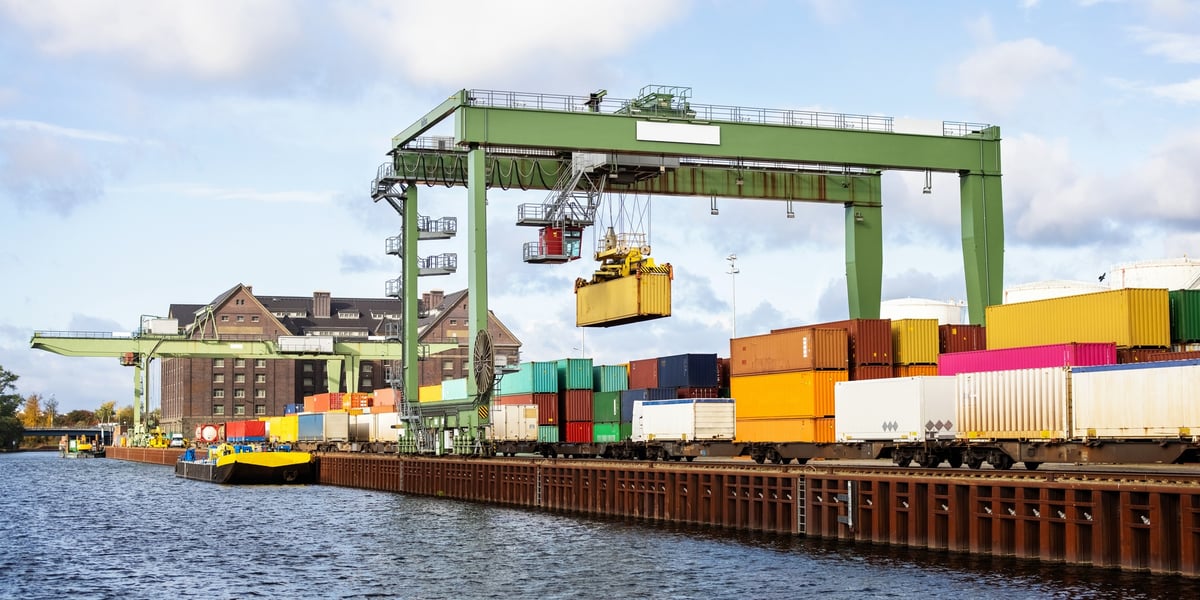Are organizations set up for success in the era of AI-powered supply chains?
Share at:

In a recent blog, I discussed why AI will be a transformational topic for chief supply chain officers. I focused on the opportunities to apply AI to address major challenges around risk management, sustainability, labor shortage, and communication processes.
With this blog post, I am focusing on the question of whether AI will change supply chain organizations from a “waterfall (value chain) model” to a “business scrum (customer centric) model.”
A waterfall model is characterized by its sequential nature and emphasizes upfront planning. A business scrum model is an iterative and flexible approach that prioritizes customer feedback and adaptation to change.
As studies have repeatedly shown, 80% of supply chain cost and 80% of the sustainability impact are defined during the engineering and research and development (R&D) process for new products and new product variants. However, typically the planning, manufacturing, and operations functions are not involved in the decision making process. And companies spend a lot of money on supply chain planning to improve forecast and planning accuracy to make downstream processes more effective. But is this the state-of-the-art approach?
Doesn’t AI present us with an opportunity to rethink the basic principles of current supply chain setups? I believe it does—here are my thoughts.
Evolution of the supply chain
Let’s start by talking about the evolution of supply chain and why current supply chain organizations are set-up along the value chain.
Supply change management is a rather "young" discipline for companies, compared to more established functions such as finance, human resources, and operations. This manifested in the evolution of CEO appointments.
Only during the last decade have chief supply chain officers had a seat at the C-suite table and been considered as potential successors for CEO positions (traditionally, chief financial officers were primarily considered for CEO roles).
In the late 1980s, “supply chain” became a topic with a focus on the procurement function for direct materials, supported by first material requirement planning (MRP) calculations. This was the time when the main supply chain philosophy was a “push” function: a product was designed, produced, and then brought to market with no (or very limited) consideration on real demand from customers. There were few product variants. The concept of the famous quote from Henry Ford in the 1920s was still holding true: “Any customer can have a car painted any color that he wants so long as it is black.”
In the late 1990s, there was a breakthrough in manufacturing as organizations thought about the flow of materials instead of machine utilization. The belief was that maximum utilization of every asset (machine) reduced the cost per product. However, machines have different capacities and semi-finished product inventory was piling up in front of the machines. This caused a slow production process.
With the introduction of advanced planning and optimization algorithms, it was possible to focus on the production flow, reduce inventory, and speed up the production process, which resulted in a big productivity gain.
At the beginning of the new millennium, companies started to outsource production (mainly to Asia and Eastern Europe) to benefit from cheap labor. No longer was there a differentiation with the production processes; addressing the mass market with affordable and high-quality products became the goal. The importance of logistics processes and global trade increased dramatically.
Around 2010, the focus was more and more on the customer-centric and demand-driven supply chain (pull principle). The technological advances in manufacturing allowed for more and more variation of products, all being produced with the same speed and quality. This was also the starting point of the so-called Industry 4.0 discussion, which referred to the digital transformation of businesses. Investments in internet of things (IoT), machine-to-machine communications, robotics, conveyer belts, etc. enabled companies to automate their physical supply chains.
Before the pandemic hit the world in 2020, society increasingly acknowledged climate change triggered by increased carbon footprint through industrialization. And then the pandemic hit and disrupted global and local supply chains. The supply chain function became the top priority for businesses and heads of states.
Chief supply chain officers began to focus on risk management and building a more resilient and sustainable supply chain. And governments introduced investments and legislation to build up regional and local manufacturing for critical products to reduce global dependencies and risk of disruptions. The need for building “digital twins” for supply chains—by combining data from the enterprise with data from the thousands of business partners and data illustrating the risk of supply chain disruptions—became the focus area to gain end-to-end supply chain visibility.
A new era: AI-powered supply chain transformation
Companies have compartmentalized the supply chain organization along the value chain: engineering R&D > supply chain planning > procurement > manufacturing > logistics > operations. The processes have been optimized by department.
Every department has a different software stack to run their processes. Why? To a large extent, it’s because this follows the evolution of the supply chain and because of a lack of computing power and technology capabilities. Technology and computer power restrictions are no longer an issue.
Now it’s time to rethink the supply chain.
Do we still need to follow the “waterfall concept” of the current organizational model?
Can we answer supply chain questions more holistically by considering all variables (at least within the enterprise)?
Is it possible to think about a new, highly collaboration end-to-end, cross-company supply chain model?
Can we increase efficiency, productivity, profitability, and focus on sustainability all at the same time?
How long will it take until we get there and is it realistic?
I think that by 2030 (at the latest) we will see the AI-powered supply chain model in action with mainstream adoption. And, as always, leaders who start now will have a huge advantage compared to laggards.
What could a future model for the supply chain look like?
As a starting point, we need to connect the dots. There are three dimensions to that:
Connecting internal organizations by breaking down process silos and automating manual, repetitive, and document-based processes. Information needs to flow more seamlessly and freely between organizations. Knowledge needs to be shared and not hidden.
Connecting with external business partners. Electronic data interchange (EDI) and application programming interface (API) have their limits—let’s use unstructured collaboration of text and data and leverage AI to bring this into the companies’ specific structures.
Connecting the more than 20 systems currently being used to run a supply chain and orchestrate processes across these systems.
The next step is to leverage AI to address holistic business problems:
Risk management: AI can play a significant role in supply chain risk management. Enterprises can leverage AI to combine information related to disruptions (e.g. climate information, geopolitical issues, healthcare data) with enterprise data to predict risk levels.
Labor shortages: there are many processes in supply chains which are still very manual, repetitive, and document-based, especially in procurement and logistics functions. Automate these processes with a combination of AI and software robots, freeing employees for higher-value work.
Sustainability: AI will help generate more optimized transportation routes and optimized loads. And, of course, more automated and optimized manufacturing processes reduce energy consumption.
Communication: AI can classify emails, understand the content of the attachments, and transform the information into structured inputs for automated follow-up processes.
And finally, companies will adopt AI for customer-centric, value-generating opportunities, which typically go across sales, finance, and supply chain organizations:
Dynamic quote pricing
One of the most important processes for companies is quoting the best possible price for their customers at any given point in time, considering the market situation, supply and demand, inventory, profitability, customer's priority, and many more criteria. This is a perfect example of an algorithm across sales, finance, and supply chain organizations, which is either not being used at all (because of complexity) or only partly being used.
Inventory reorder points
Of course, we need to discuss inventory management as well. Getting the inventory levels “right,” is the key for a successful supply chain and a successful company. Holding very low inventory creates the risk of running out of stock but is beneficial from a finance perspective. Having a lot of inventory at hand guarantees high customer satisfaction but creates a financial disadvantage. So, it’s about the right mix, which includes considering customers' satisfaction, financial goals, and supply chain targets.
Field service management
Customer centricity doesn’t stop with having the product delivered to the customer (exactly as they requested it). Providing the right service level for the time after the original purchase is as important as keeping customer satisfaction at a high point. This process requires the right combination of setting customer service levels, financial targets, and inventory targets at the right level.
Key takeaways
Supply chain organizations have evolved. Traditionally, they were built along the value chain by creating units which were optimized and managed independently from each other. This created “silos” within the enterprise, limited communication with external partners, and required over 20 software systems to manage the entire value chain.
By connecting the dots and applying automation and AI for holistic and customer centric processes, the issues related to current organizational setups can be resolved.
Claim your copy of the supply chain e-book to find out how to take the vision for an autonomous supply chain and make it a reality by using automation to put AI to work.
Have more time? Watch "AI and automation in supply chain." This on-demand webinar is presented in partnership with UiPath, SAP, and Deloitte.

Global Supply Chain Practice Executive, UiPath
Get articles from automation experts in your inbox
SubscribeGet articles from automation experts in your inbox
Sign up today and we'll email you the newest articles every week.
Thank you for subscribing!
Thank you for subscribing! Each week, we'll send the best automation blog posts straight to your inbox.



